Hongbin Liu
PADReg: Physics-Aware Deformable Registration Guided by Contact Force for Ultrasound Sequences
Aug 12, 2025Abstract:Ultrasound deformable registration estimates spatial transformations between pairs of deformed ultrasound images, which is crucial for capturing biomechanical properties and enhancing diagnostic accuracy in diseases such as thyroid nodules and breast cancer. However, ultrasound deformable registration remains highly challenging, especially under large deformation. The inherently low contrast, heavy noise and ambiguous tissue boundaries in ultrasound images severely hinder reliable feature extraction and correspondence matching. Existing methods often suffer from poor anatomical alignment and lack physical interpretability. To address the problem, we propose PADReg, a physics-aware deformable registration framework guided by contact force. PADReg leverages synchronized contact force measured by robotic ultrasound systems as a physical prior to constrain the registration. Specifically, instead of directly predicting deformation fields, we first construct a pixel-wise stiffness map utilizing the multi-modal information from contact force and ultrasound images. The stiffness map is then combined with force data to estimate a dense deformation field, through a lightweight physics-aware module inspired by Hooke's law. This design enables PADReg to achieve physically plausible registration with better anatomical alignment than previous methods relying solely on image similarity. Experiments on in-vivo datasets demonstrate that it attains a HD95 of 12.90, which is 21.34\% better than state-of-the-art methods. The source code is available at https://github.com/evelynskip/PADReg.
F2PASeg: Feature Fusion for Pituitary Anatomy Segmentation in Endoscopic Surgery
Aug 07, 2025Abstract:Pituitary tumors often cause deformation or encapsulation of adjacent vital structures. Anatomical structure segmentation can provide surgeons with early warnings of regions that pose surgical risks, thereby enhancing the safety of pituitary surgery. However, pixel-level annotated video stream datasets for pituitary surgeries are extremely rare. To address this challenge, we introduce a new dataset for Pituitary Anatomy Segmentation (PAS). PAS comprises 7,845 time-coherent images extracted from 120 videos. To mitigate class imbalance, we apply data augmentation techniques that simulate the presence of surgical instruments in the training data. One major challenge in pituitary anatomy segmentation is the inconsistency in feature representation due to occlusions, camera motion, and surgical bleeding. By incorporating a Feature Fusion module, F2PASeg is proposed to refine anatomical structure segmentation by leveraging both high-resolution image features and deep semantic embeddings, enhancing robustness against intraoperative variations. Experimental results demonstrate that F2PASeg consistently segments critical anatomical structures in real time, providing a reliable solution for intraoperative pituitary surgery planning. Code: https://github.com/paulili08/F2PASeg.
Multimodal Causal-Driven Representation Learning for Generalizable Medical Image Segmentation
Aug 07, 2025Abstract:Vision-Language Models (VLMs), such as CLIP, have demonstrated remarkable zero-shot capabilities in various computer vision tasks. However, their application to medical imaging remains challenging due to the high variability and complexity of medical data. Specifically, medical images often exhibit significant domain shifts caused by various confounders, including equipment differences, procedure artifacts, and imaging modes, which can lead to poor generalization when models are applied to unseen domains. To address this limitation, we propose Multimodal Causal-Driven Representation Learning (MCDRL), a novel framework that integrates causal inference with the VLM to tackle domain generalization in medical image segmentation. MCDRL is implemented in two steps: first, it leverages CLIP's cross-modal capabilities to identify candidate lesion regions and construct a confounder dictionary through text prompts, specifically designed to represent domain-specific variations; second, it trains a causal intervention network that utilizes this dictionary to identify and eliminate the influence of these domain-specific variations while preserving the anatomical structural information critical for segmentation tasks. Extensive experiments demonstrate that MCDRL consistently outperforms competing methods, yielding superior segmentation accuracy and exhibiting robust generalizability.
MM2CT: MR-to-CT translation for multi-modal image fusion with mamba
Aug 07, 2025Abstract:Magnetic resonance (MR)-to-computed tomography (CT) translation offers significant advantages, including the elimination of radiation exposure associated with CT scans and the mitigation of imaging artifacts caused by patient motion. The existing approaches are based on single-modality MR-to-CT translation, with limited research exploring multimodal fusion. To address this limitation, we introduce Multi-modal MR to CT (MM2CT) translation method by leveraging multimodal T1- and T2-weighted MRI data, an innovative Mamba-based framework for multi-modal medical image synthesis. Mamba effectively overcomes the limited local receptive field in CNNs and the high computational complexity issues in Transformers. MM2CT leverages this advantage to maintain long-range dependencies modeling capabilities while achieving multi-modal MR feature integration. Additionally, we incorporate a dynamic local convolution module and a dynamic enhancement module to improve MRI-to-CT synthesis. The experiments on a public pelvis dataset demonstrate that MM2CT achieves state-of-the-art performance in terms of Structural Similarity Index Measure (SSIM) and Peak Signal-to-Noise Ratio (PSNR). Our code is publicly available at https://github.com/Gots-ch/MM2CT.
EndoMatcher: Generalizable Endoscopic Image Matcher via Multi-Domain Pre-training for Robot-Assisted Surgery
Aug 07, 2025Abstract:Generalizable dense feature matching in endoscopic images is crucial for robot-assisted tasks, including 3D reconstruction, navigation, and surgical scene understanding. Yet, it remains a challenge due to difficult visual conditions (e.g., weak textures, large viewpoint variations) and a scarcity of annotated data. To address these challenges, we propose EndoMatcher, a generalizable endoscopic image matcher via large-scale, multi-domain data pre-training. To address difficult visual conditions, EndoMatcher employs a two-branch Vision Transformer to extract multi-scale features, enhanced by dual interaction blocks for robust correspondence learning. To overcome data scarcity and improve domain diversity, we construct Endo-Mix6, the first multi-domain dataset for endoscopic matching. Endo-Mix6 consists of approximately 1.2M real and synthetic image pairs across six domains, with correspondence labels generated using Structure-from-Motion and simulated transformations. The diversity and scale of Endo-Mix6 introduce new challenges in training stability due to significant variations in dataset sizes, distribution shifts, and error imbalance. To address them, a progressive multi-objective training strategy is employed to promote balanced learning and improve representation quality across domains. This enables EndoMatcher to generalize across unseen organs and imaging conditions in a zero-shot fashion. Extensive zero-shot matching experiments demonstrate that EndoMatcher increases the number of inlier matches by 140.69% and 201.43% on the Hamlyn and Bladder datasets over state-of-the-art methods, respectively, and improves the Matching Direction Prediction Accuracy (MDPA) by 9.40% on the Gastro-Matching dataset, achieving dense and accurate matching under challenging endoscopic conditions. The code is publicly available at https://github.com/Beryl2000/EndoMatcher.
The Docking Game: Loop Self-Play for Fast, Dynamic, and Accurate Prediction of Flexible Protein--Ligand Binding
Aug 07, 2025Abstract:Molecular docking is a crucial aspect of drug discovery, as it predicts the binding interactions between small-molecule ligands and protein pockets. However, current multi-task learning models for docking often show inferior performance in ligand docking compared to protein pocket docking. This disparity arises largely due to the distinct structural complexities of ligands and proteins. To address this issue, we propose a novel game-theoretic framework that models the protein-ligand interaction as a two-player game called the Docking Game, with the ligand docking module acting as the ligand player and the protein pocket docking module as the protein player. To solve this game, we develop a novel Loop Self-Play (LoopPlay) algorithm, which alternately trains these players through a two-level loop. In the outer loop, the players exchange predicted poses, allowing each to incorporate the other's structural predictions, which fosters mutual adaptation over multiple iterations. In the inner loop, each player dynamically refines its predictions by incorporating its own predicted ligand or pocket poses back into its model. We theoretically show the convergence of LoopPlay, ensuring stable optimization. Extensive experiments conducted on public benchmark datasets demonstrate that LoopPlay achieves approximately a 10\% improvement in predicting accurate binding modes compared to previous state-of-the-art methods. This highlights its potential to enhance the accuracy of molecular docking in drug discovery.
Harnessing Foundation Models for Robust and Generalizable 6-DOF Bronchoscopy Localization
May 30, 2025Abstract:Vision-based 6-DOF bronchoscopy localization offers a promising solution for accurate and cost-effective interventional guidance. However, existing methods struggle with 1) limited generalization across patient cases due to scarce labeled data, and 2) poor robustness under visual degradation, as bronchoscopy procedures frequently involve artifacts such as occlusions and motion blur that impair visual information. To address these challenges, we propose PANSv2, a generalizable and robust bronchoscopy localization framework. Motivated by PANS that leverages multiple visual cues for pose likelihood measurement, PANSv2 integrates depth estimation, landmark detection, and centerline constraints into a unified pose optimization framework that evaluates pose probability and solves for the optimal bronchoscope pose. To further enhance generalization capabilities, we leverage the endoscopic foundation model EndoOmni for depth estimation and the video foundation model EndoMamba for landmark detection, incorporating both spatial and temporal analyses. Pretrained on diverse endoscopic datasets, these models provide stable and transferable visual representations, enabling reliable performance across varied bronchoscopy scenarios. Additionally, to improve robustness to visual degradation, we introduce an automatic re-initialization module that detects tracking failures and re-establishes pose using landmark detections once clear views are available. Experimental results on bronchoscopy dataset encompassing 10 patient cases show that PANSv2 achieves the highest tracking success rate, with an 18.1% improvement in SR-5 (percentage of absolute trajectory error under 5 mm) compared to existing methods, showing potential towards real clinical usage.
Nemotron-H: A Family of Accurate and Efficient Hybrid Mamba-Transformer Models
Apr 10, 2025

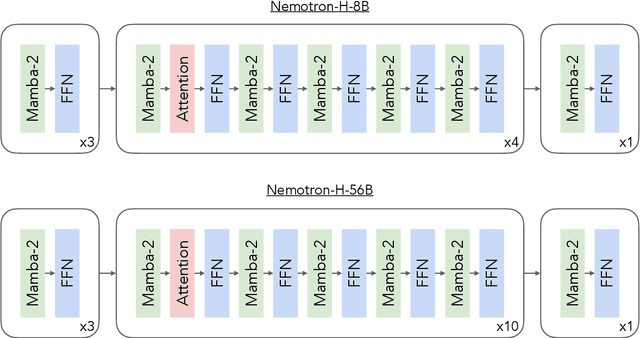
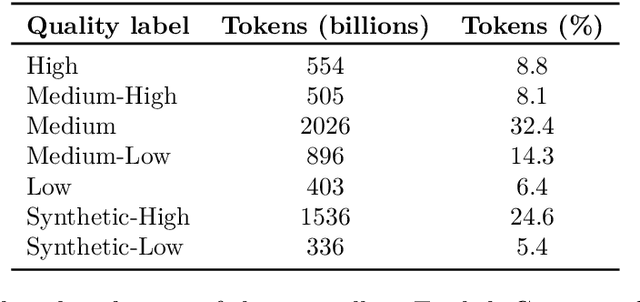
Abstract:As inference-time scaling becomes critical for enhanced reasoning capabilities, it is increasingly becoming important to build models that are efficient to infer. We introduce Nemotron-H, a family of 8B and 56B/47B hybrid Mamba-Transformer models designed to reduce inference cost for a given accuracy level. To achieve this goal, we replace the majority of self-attention layers in the common Transformer model architecture with Mamba layers that perform constant computation and require constant memory per generated token. We show that Nemotron-H models offer either better or on-par accuracy compared to other similarly-sized state-of-the-art open-sourced Transformer models (e.g., Qwen-2.5-7B/72B and Llama-3.1-8B/70B), while being up to 3$\times$ faster at inference. To further increase inference speed and reduce the memory required at inference time, we created Nemotron-H-47B-Base from the 56B model using a new compression via pruning and distillation technique called MiniPuzzle. Nemotron-H-47B-Base achieves similar accuracy to the 56B model, but is 20% faster to infer. In addition, we introduce an FP8-based training recipe and show that it can achieve on par results with BF16-based training. This recipe is used to train the 56B model. All Nemotron-H models will be released, with support in Hugging Face, NeMo, and Megatron-LM.
Bayesian Test-Time Adaptation for Vision-Language Models
Mar 12, 2025Abstract:Test-time adaptation with pre-trained vision-language models, such as CLIP, aims to adapt the model to new, potentially out-of-distribution test data. Existing methods calculate the similarity between visual embedding and learnable class embeddings, which are initialized by text embeddings, for zero-shot image classification. In this work, we first analyze this process based on Bayes theorem, and observe that the core factors influencing the final prediction are the likelihood and the prior. However, existing methods essentially focus on adapting class embeddings to adapt likelihood, but they often ignore the importance of prior. To address this gap, we propose a novel approach, \textbf{B}ayesian \textbf{C}lass \textbf{A}daptation (BCA), which in addition to continuously updating class embeddings to adapt likelihood, also uses the posterior of incoming samples to continuously update the prior for each class embedding. This dual updating mechanism allows the model to better adapt to distribution shifts and achieve higher prediction accuracy. Our method not only surpasses existing approaches in terms of performance metrics but also maintains superior inference rates and memory usage, making it highly efficient and practical for real-world applications.
Accelerated Quasi-Static FEM for Real-Time Modeling of Continuum Robots with Multiple Contacts and Large Deformation
Mar 10, 2025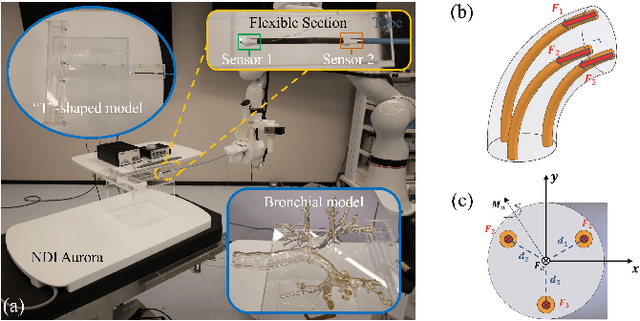
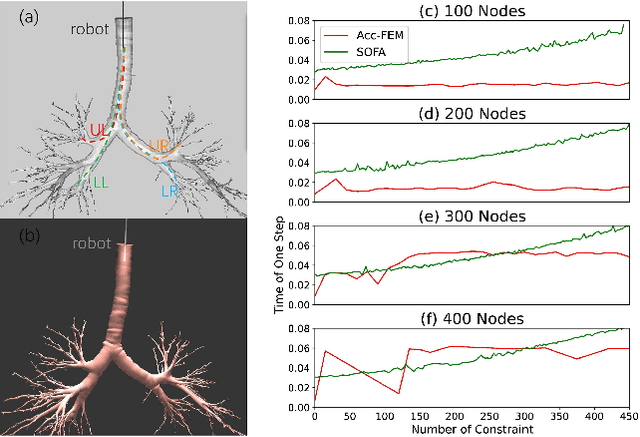
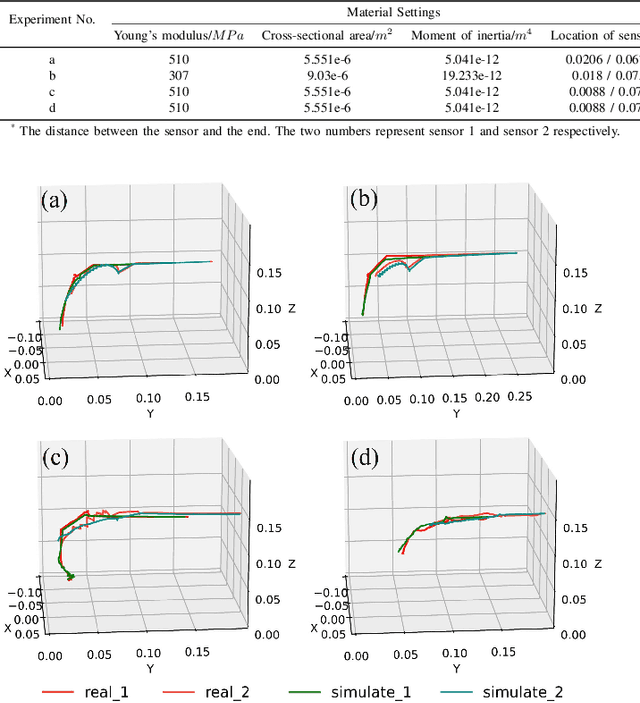

Abstract:Continuum robots offer high flexibility and multiple degrees of freedom, making them ideal for navigating narrow lumens. However, accurately modeling their behavior under large deformations and frequent environmental contacts remains challenging. Current methods for solving the deformation of these robots, such as the Model Order Reduction and Gauss-Seidel (GS) methods, suffer from significant drawbacks. They experience reduced computational speed as the number of contact points increases and struggle to balance speed with model accuracy. To overcome these limitations, we introduce a novel finite element method (FEM) named Acc-FEM. Acc-FEM employs a large deformation quasi-static finite element model and integrates an accelerated solver scheme to handle multi-contact simulations efficiently. Additionally, it utilizes parallel computing with Graphics Processing Units (GPU) for real-time updates of the finite element models and collision detection. Extensive numerical experiments demonstrate that Acc-FEM significantly improves computational efficiency in modeling continuum robots with multiple contacts while achieving satisfactory accuracy, addressing the deficiencies of existing methods.
 Add to Chrome
Add to Chrome Add to Firefox
Add to Firefox Add to Edge
Add to Edge